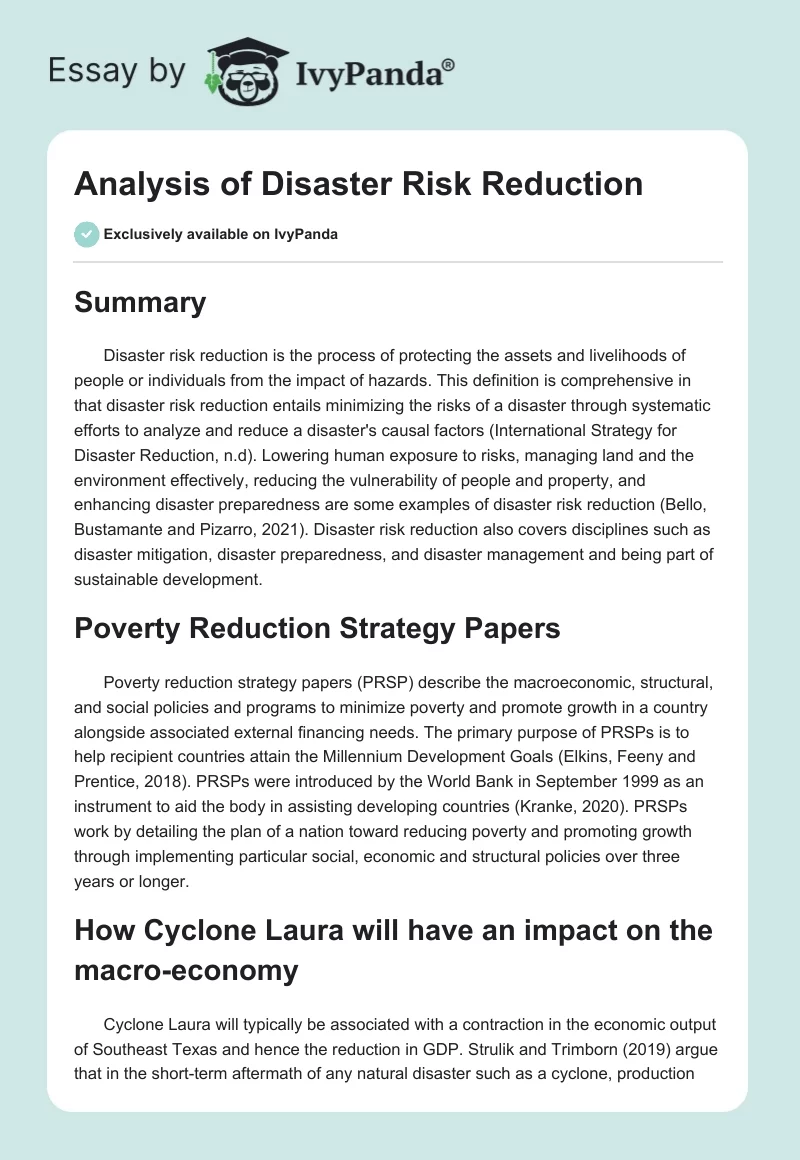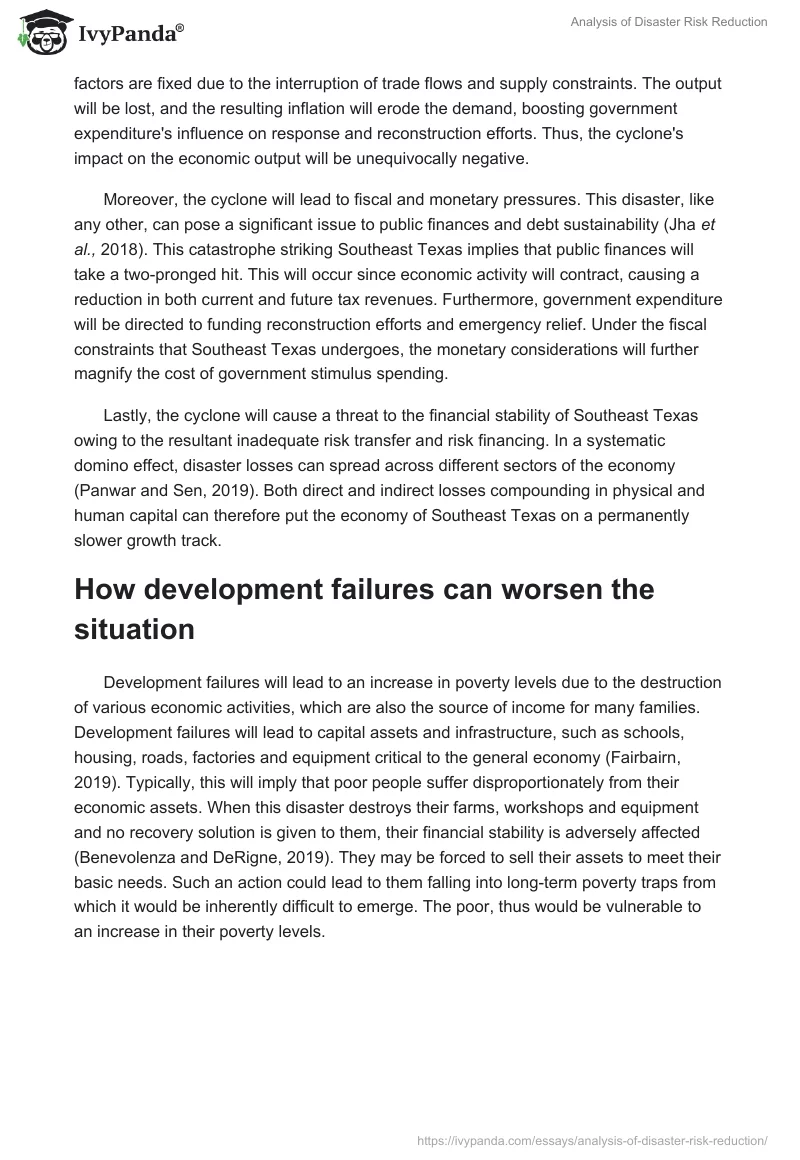Summary
Disaster risk reduction is the process of protecting the assets and livelihoods of people or individuals from the impact of hazards. This definition is comprehensive in that disaster risk reduction entails minimizing the risks of a disaster through systematic efforts to analyze and reduce a disaster’s causal factors (International Strategy for Disaster Reduction, n.d). Lowering human exposure to risks, managing land and the environment effectively, reducing the vulnerability of people and property, and enhancing disaster preparedness are some examples of disaster risk reduction (Bello, Bustamante and Pizarro, 2021). Disaster risk reduction also covers disciplines such as disaster mitigation, disaster preparedness, and disaster management and being part of sustainable development.
Poverty Reduction Strategy Papers
Poverty reduction strategy papers (PRSP) describe the macroeconomic, structural, and social policies and programs to minimize poverty and promote growth in a country alongside associated external financing needs. The primary purpose of PRSPs is to help recipient countries attain the Millennium Development Goals (Elkins, Feeny and Prentice, 2018). PRSPs were introduced by the World Bank in September 1999 as an instrument to aid the body in assisting developing countries (Kranke, 2020). PRSPs work by detailing the plan of a nation toward reducing poverty and promoting growth through implementing particular social, economic and structural policies over three years or longer.
How Cyclone Laura will have an impact on the macro-economy
Cyclone Laura will typically be associated with a contraction in the economic output of Southeast Texas and hence the reduction in GDP. Strulik and Trimborn (2019) argue that in the short-term aftermath of any natural disaster such as a cyclone, production factors are fixed due to the interruption of trade flows and supply constraints. The output will be lost, and the resulting inflation will erode the demand, boosting government expenditure’s influence on response and reconstruction efforts. Thus, the cyclone’s impact on the economic output will be unequivocally negative.
Moreover, the cyclone will lead to fiscal and monetary pressures. This disaster, like any other, can pose a significant issue to public finances and debt sustainability (Jha et al., 2018). This catastrophe striking Southeast Texas implies that public finances will take a two-pronged hit. This will occur since economic activity will contract, causing a reduction in both current and future tax revenues. Furthermore, government expenditure will be directed to funding reconstruction efforts and emergency relief. Under the fiscal constraints that Southeast Texas undergoes, the monetary considerations will further magnify the cost of government stimulus spending.
Lastly, the cyclone will cause a threat to the financial stability of Southeast Texas owing to the resultant inadequate risk transfer and risk financing. In a systematic domino effect, disaster losses can spread across different sectors of the economy (Panwar and Sen, 2019). Both direct and indirect losses compounding in physical and human capital can therefore put the economy of Southeast Texas on a permanently slower growth track.
How development failures can worsen the situation
Development failures will lead to an increase in poverty levels due to the destruction of various economic activities, which are also the source of income for many families. Development failures will lead to capital assets and infrastructure, such as schools, housing, roads, factories and equipment critical to the general economy (Fairbairn, 2019). Typically, this will imply that poor people suffer disproportionately from their economic assets. When this disaster destroys their farms, workshops and equipment and no recovery solution is given to them, their financial stability is adversely affected (Benevolenza and DeRigne, 2019). They may be forced to sell their assets to meet their basic needs. Such an action could lead to them falling into long-term poverty traps from which it would be inherently difficult to emerge. The poor, thus would be vulnerable to an increase in their poverty levels.
Disaster risk reduction plan
Cyclone Idai and the millennium goals
Cyclone Idai hitting South Africa set back millennium goals in various ways. Firstly, the plan to eradicate poverty and hunger was affected since the cyclone led to the destruction of more than 700,000 hectares of crops in Mozambique alone due to flooding (Lager, 2021). The goals to achieve universal primary education and promote gender equality and women empowerment were hampered as the cyclone increased women’s and girls’ daily chores. They had to travel long distances to find firewood water; hence their education was paralyzed. Furthermore, this cyclone hindered the efforts of the millennium goals to reduce child mortality as the displacement that resulted following this disaster put children at risk of exploitation and separation from families, hence lowering their chances of dying from hunger and other related causes.
Additionally, the MDGs aim to combat HIV/AIDS, malaria, and other diseases encountered a setback as conditions became rampant due to the floods. Further, access to health services was paralyzed; hence people became susceptible to dying from these emergent diseases. The cyclone hampered MDG’s goal to improve maternal health as health centers were rendered dysfunctional at the onset of the cyclone. Women thus had to give birth under unacceptable conditions, thus endangering their lives.
Finally, cyclone Idai was a setback to the MDGs goal to ensure environmental sustainability. The cyclone caused a crippling economic crisis which resultantly paralyzed the efforts of the governments to implement sustainability practices as the funds were directed to mitigating the calamity. Amidst the worsening climate crisis, various governments struggle to acquire financial resources to implement adequate and speedy environmental recovery efforts.
Reference List
Bello, O. Bustamante, A. and Pizarro, P. (2021). ‘Planning for disaster risk reduction within the framework of the 2030 Agenda for Sustainable Development,’ Project Documents (LC/TS.2020/108), Santiago, Economic Commission for Latin America and the Caribbean (ECLAC). Web.
Benevolenza, M.A. and DeRigne, L. (2019). ‘The impact of climate change and natural disasters on vulnerable populations: A systematic review of literature’, Journal of Human Behavior in the Social Environment, 29(2), pp.266-281. Web.
Elkins, M. Feeny, S. and Prentice, D. (2018). ‘Are poverty reduction strategy papers associated with reductions in poverty and improvements in well-being?’, The Journal of Development Studies, 54(2), pp.377-393. Web.
Fairbairn, T.I. (2019). ‘Economic consequences of natural disasters among Pacific island countries,’ Australian National University.
International Strategy for Disaster Reduction (ISDR), (n.d). What is Disaster Risk Reduction? Web.
Jha, S., et al. (2018). Natural disasters, public spending, and creative destruction: a case study of the Philippines, ADBI Working Paper, No. 817, Asian Development Bank Institute (ADBI), Tokyo. Web.
Kranke, M. (2020). IMF-World Bank cooperation before and after the global financial crisis, Global Policy, 11(1), pp.15-25. Web.
Lager, Z. (2021). ‘A community model for water-energy-food security nexus development: cultivating sustainable livelihoods and an adaptive co-management approach in rural Mozambique.’ Web.
Panwar, V. and Sen, S. (2019). ‘Economic impact of natural disasters: An empirical re-examination,’ Margin: The Journal of Applied Economic Research, 13(1), pp.109-139.
Strulik, H. and Trimborn, T. (2019). ‘Natural disasters and macroeconomic performance,’ Environmental and Resource Economics, 72(4), pp.1069-1098.


